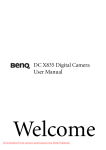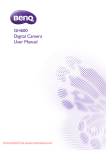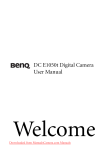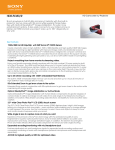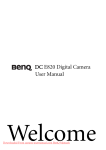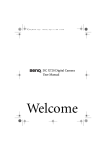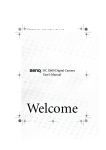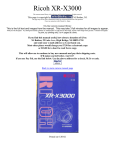Download BenQ DC X725 User manual
Transcript
DC X725 Digital Camera User Manual Welcome Downloaded From camera-usermanual.com BenQ Manuals Copyright Copyright 2007 by BenQ Corporation. All rights reserved. No part of this publication may be reproduced, transmitted, transcribed, stored in a retrieval system or translated into any language or computer language, in any form or by any means, electronic, mechanical, magnetic, optical, chemical, manual or otherwise, without the prior written permission of this company. Disclaimer BenQ Corporation makes no representations or warranties, either expressed or implied, with respect to the contents hereof and specifically disclaims any warranties, merchantability or fitness for any particular purpose. Further, BenQ Corporation reserves the right to revise this publication and to make changes from time to time in the contents hereof without obligation of this company to notify any person of such revision or changes. Taking care of your camera • The camera operating temperature is between 0 and 40 degrees Celsius. It is normal for the operating time to be shortened when the temperature is low. • Do not use or store your camera in the environments listed below: • Direct sunlight • High and dusty places • Next to an air conditioner, electric heater or other heat sources • In a closed car that is in direct sunlight • Unstable locations • If your camera becomes wet, wipe it with a dry cloth as soon as possible. • Salt or seawater may cause severe camera damage. • Do not use solvents, such as alcohol, to clean your camera. • If the lens is dirty, use a lens brush or soft cloth to clean the lens. Do not touch the lens with your fingers. • To prevent electric shock, do not attempt to disassemble or repair your camera by yourself. • Water may cause a fire or electric shock. Therefore, store your camera in a dry place. • Do not use your camera outdoors when it is raining or snowing. • Do not use your camera in or near water. • If a foreign substance or water gets in your camera, please turn the power off immediately and disconnect the batteries and the power adapter. Remove the foreign substance or water, and send it to the maintenance center. • Transfer the data to the computer as soon as possible to avoid losing your images and/or video clips. Disposal of Waste Electrical and Electronic Equipment by users in private households in the European Union. This symbol on the product or on the packaging indicates that this can not be disposed of as household waste. You must dispose of your waste equipment by handing it over to the applicable take-back scheme for the recycling of electrical and electronic equipment. For more information about recycling of this equipment, please contact your city office, the shop where you purchased the equipment or your household waste disposal service. The recycling of materials will help to conserve natural resources and ensure that it is recycled in a manner that protects human health and environment. CE Regulatory Notice Hereby, BenQ Corp. declares under our responsibility that the product is in conformity with the requirements set out in the Council Directive on the Approximation of the Laws of the Member States relating, Electromagnetic Compatibility Directives (89/336/EEC, 92/31/EEC) and Low Voltage Directive (73/23/EEC). Downloaded From camera-usermanual.com BenQ Manuals A “Declaration of Conformity” in accordance with the above Directives has been made and is available from BenQ Corp. upon request. FCC Statement This equipment has been tested and found to comply with the limits for a Class B digital device, pursuant to Part 15 of the FCC Rules. These limits are designed to provide reasonable protection against harmful interference in a residential installation. This equipment generates, uses and can radiate radio frequency energy and, if not installed and used in accordance with the instructions, may cause harmful interference to radio communications. However, there is no guarantee that interference will not occur in a particular installation. If this equipment does cause harmful interference to radio or television reception, which can be determined by turning the equipment off and on, the user is encouraged to try to correct the interference by one or more of the following measures: • Reorient or relocate the receiving antenna. • Increase the separation between the equipment and receiver. • Connect the equipment into an outlet on a circuit different from that to which the receiver is connected. • Consult the dealer or an experienced radio/TV technician for help. Downloaded From camera-usermanual.com BenQ Manuals Table of Contents Table of Contents English Touring the camera ......................1 Options for playback and editing 17 Checking the package contents ..... 1 Camera components ..................... 1 Enlarging an image ........................ 17 Viewing multiple files at a time .... 17 Protecting ....................................... 17 Deleting files .................................. 17 Rotating an image .......................... 18 Slideshow ....................................... 18 Trimming ....................................... 18 Resizing .......................................... 18 Voice memo ................................... 19 Startup screen ................................ 19 Front view and bottom view ...........1 Rear view ..........................................2 Preparing the camera for use .......2 Charging the battery ...................... 3 Using multifunctional buttons ..... 3 Using an SD card ........................... 4 Setting language ............................. 4 Setting date and time ..................... 4 Working with computer and AV Operating the camera ...................5 Capture mode .............................6 system .......................................... 19 Bundled software ......................... 19 Connecting the camera to a computer ...................................... 19 Connecting the camera to an AV system ........................................... 20 Printing images ............................ 20 Scene mode .................................... 7 Flash mode ..................................... 9 Focus mode .................................. 10 Drive mode .................................. 10 Printing with PictBridge ................ 20 Image size ..................................... 11 Image quality ............................... 11 Troubleshooting and service AF area ......................................... 11 information ................................. 21 Battery status ................................ 12 Technical support ........................ 22 Setting EV .................................... 12 AE metering ................................. 12 Specifications .............................. 23 White balance .............................. 13 ISO sensitivity .............................. 13 Effect ............................................. 14 Date Stamp ................................... 14 Setting sharpness, saturation and contrast ......................................... 14 Movie Record mode settings ....... 14 Other settings ..............................15 Playback mode ............................16 Downloaded From camera-usermanual.com BenQ Manuals Touring the camera 1 Checking the package contents Carefully unpack your kit box and ensure that you have the following items. 1. User Manual 2. Digital camera 3. USB cable 4. Battery 5. Hand strap 6. Leather case 7. Software CD 8. Battery charger 9. AC power adapter 10. AV cable • Available accessories may vary depending on sales region. • If any items are missing or damaged, contact your dealer. • Save the packaging for future shipment or storage. Camera components Front view and bottom view 1. Shutter button 2. Status LED indicator 3. Power button 4. Flash 5. Self-timer LED indicator 6. Lens and lens cover 7. Microphone 8. Battery/SD card cover 9. USB port 10. Tripod mount Downloaded From camera-usermanual.com BenQ Manuals English Touring the camera 2 Preparing the camera for use Rear view English 1. LCD display 2. W (Wide) : Zoom-out or thumbnail view (playback) 3. T (Tele) : Zoom-in 4. Strap eyelet 5. Play button 6. Capture mode (toggling between still image capturing and movie recording) 7. Multifunctional buttons (including a 4-way control and an button) 8. On-screen instructions (when selecting a scene mode) or delete photos (playback mode) or return to 9. MENU button the previous menu 10. Speaker • It is normal for the camera to become warm during operation, because metal camera casing can conduct heat. • The LCD display on this camera is manufactured with sophisticated technology, and more than 99.99% of the pixels on the LCD display meet standard specifications. Yet, it is possible that less than 0.01% of the pixels on the LCD display may have some light spots or show unusual colors. This is normal and does not indicate display malfunction, nor will this affect the pictures you take with the camera. Preparing the camera for use Use only the specified battery for the camera, and always turn off the camera before inserting or removing the battery. A To install the battery: B 1. Open the battery/SD card cover (A). 2. Insert the battery in the correct direction (B). 3. Push the battery all the way down, until the battery lock lever clicks into place (C). 4. Close the battery/SD card cover (D). Downloaded From camera-usermanual.com BenQ Manuals Preparing the camera for use 3 1. 2. 3. 4. Open the battery/SD card cover. Press and hold the battery. Release the battery lock lever. When the battery has come out a little, gently pull it out the rest of the way. 5. Close the battery/SD card cover. D Charging the battery The battery charge status affects the camera performance. To maximize the performance and the battery life, fully charge the battery using the specified charger and AC power adapter, and then fully discharge it through normal use at least once. To charge the battery: 1. Insert the battery into the battery charger. 2. Connect one end of the AC power adapter to the battery charger. 3. Connect the other end of the AC power adapter to a wall outlet. 4. When the battery is being charged, the charger LED indicator lights up in red. When the battery is fully charged, it turns into green. • Damage caused by the use of an incorrect battery charger set is not covered under the warranty. • The battery may be warm after being charged or used. This is normal and not a malfunction. • When using the camera in a cold environment, keep the camera and its battery warm by holding it inside your jacket or another warm protective environment. Using multifunctional buttons You can choose camera settings by pressing the 4-way control or the button. 1. Left/Focus: • Scrolls left in menus. • Selects a focus mode. 2. Up/EV: • Scrolls up in menus. • Sets EV (use and to select an exposure value). 3. Right/Flash: • Scrolls right in menus. • Selects a flash mode. 4. Down/Drive: • Scrolls down in menus. • Selects a drive mode (Standard/Self-timer/Continuous Shoot/Interval Shoot/. 5. : Confirms a chosen setting. Downloaded From camera-usermanual.com BenQ Manuals English To remove the battery: C 4 Preparing the camera for use Using an SD card English The camera comes with internal memory for storing captured images, video clips, or audio files. You can also add an SD (Secure Digital) card to store more files. To install an SD card: 1. 2. 3. 4. Make sure the camera is turned off. Open the battery/SD card cover. Insert an SD card in the correct direction. Close the battery/SD card cover. To remove an SD card: 1. 2. 3. 4. Make sure the camera is turned off. Open the battery/SD card cover. Press lightly the edge of the SD card to eject. Close the battery/SD card cover. Before initial use of an SD card, press > > Manage Memory > > to format the card first. Remember to slide the write-protect tab (on the side of the SD card) to the unlock position. Otherwise, all data (if any) on the SD card is protected and the card cannot be formatted. Setting language Selects the language version shown on the screen. To select a language: 1. Press > 2. Press 3. Press or > Language. > or to locate the language you want. . Setting date and time When first time using the camera or the battery has been removed from the camera for a long time, you need to set the date and time. They are used to record when a file was captured. To set date and time: 1. Press 2. Press > or 3. Press or needed. 4. Press . to locate Date/Time, and then press to select date and time. Press or or . to move to another column as . Downloaded From camera-usermanual.com BenQ Manuals Operating the camera 5 The procedure below is a general guideline for basic operation. It is particularly useful if you are new to the camera. 1. Press 2. Press , . > and , , , or to locate a desired options (under three different tabs: ), and then press or to make selections. Remember to follow the on-screen display and instructions (wherever available) or press for more information. Next, press corresponding buttons to access and set more options. At any time, you can cancel the current operation by pressing to return to your previous step. 3. Press to zoom-in or to zoom-out. 4. Press the shutter halfway to set automatic focus. Once the focus is set, the focus frame color will turn from white (unfocused) to yellow-green (focused). 5. Press the shutter down fully to capture. 6. Release the shutter. 7. In the Movie Record mode, press the shutter to stop video recording. 8. Press to view captured images or recorded videos, and then press different images/videos. You can also press or press to view 9 images on the screen. or , or to move to to zoom-in/out a captured images, • During zoom-in/out, there is a separator in the zoom bar between and . For best image quality, it is recommended to use optical zoom only by keeping the magnification within and the separator. • Flash is automatically turned off in the Movie Record mode. • The Movie Record mode records both sound and video. The recording time is continuous, but recording will stop once the SD card space is full. • Anytime in the playback mode, you can press to switch to the capture mode. • At any time, you can press to turn off the camera. • In capture or playback mode, press screen. to decide what information to show on the Digital Zoom Optical Zoom Downloaded From camera-usermanual.com BenQ Manuals English Operating the camera 6 Capture mode Capture mode English Item Description Page reference 1 Scene mode 7 2 Flash mode 9 3 Focus mode 10 4 Drive mode 10 5 Zoom bar 5 6 Image size 11 7 Number of shots available -- 8 Image quality 11 9 AF area 11 10 Battery status 12 11 Histogram -- 12 Exposure value (EV) 12 13 AE metering 12 14 White balance 13 15 ISO sensitivity 13 • In the capture mode, press to toggle among 4 display modes (standard, complete, none, and rule of thirds). Use the rule of thirds display mode to improve your composition by placing subjects on at least one of the intersections of these 4 imaginary lines. • While the shutter is pressed halfway, the shutter speed and the aperture are also shown on the screen (not available in the Movie Record mode). Downloaded From camera-usermanual.com BenQ Manuals Capture mode 7 Scene mode Icon Mode Description Auto Lets the camera automatically decide most settings, so you can capture images with ease. Manual Lets you decide all available shooting parameters. Movie Record Captures videos with sound. When viewing the captured video file later, the icon shows indicating that this is a video file. S.S.F. (Super Shake-Free) Reduces blur caused by camera vibration, and thus improves image quality and clearness. ISO value is also automatically adjusted based on the ambient brightness. Portrait Makes the subject (usually a person) stand out with a brighter look. Landscape Used when taking pictures of natural scenery. Sports Captures a fast-moving subject. Backlight Compensates for exposure in a strong backlit environment. Flash is always on. Night Scene Used when taking a picture in the evening, night, or a low-light environment. Beach Used under a very bright light environment such as beaches. Snow Used under a very bright light environment such as snow scenes. Fireworks Used when taking a picture of exploding fireworks. Night Scene Portrait Keeps both the subject and the night scene clearly. Self-Portrait Helps take a picture of yourself (and other subjects if available). Building Line contrasts of a building are highlighted. Soft Flowing Water Captures the moments of motion blur on water. Landscape Portrait Makes the subject (usually a person) stand out while the background is blurred slightly. Downloaded From camera-usermanual.com BenQ Manuals English Select one of the following scene modes to fit your shooting condition. 8 Capture mode English Web Auction Optimizes image file size for use on the Internet. High ISO Portrait Takes a clear picture In a low-light environment. Flash is always off. Food Captures food by enhancing color brightness and giving more vivid colors. Museum Used when taking a picture of subjects in a place where flash is usually prohibited. Flash is always off. Candle Light Makes a picture look warm, and thus captures the mood under candle light source. Flash is always off. Party Captures the party atmosphere usually under indoor light source. Text Takes a picture of clear text by reducing image distortion usually found on paper, magazines, or books. Child Retains enough colors and skin tones of the subject. Sunset Captures the warmth and atmosphere of sunset. Flower Captures brightly colored flowers by enhancing their soft outlines. Pet Take a clear picture of a pet by showing its correct fur color. Voice Record Captures background sound only (no images or videos). When listening to the captured audio file later, the icon shows indicating that this is an audio file. For some scene modes like Auto, options ISO, Metering, and White Balance are not available. You must select another mode like Manual to enable these options. To select a scene mode: 1. Press > . 2. The currently selected scene mode shows. Press desired option. , , When you are selecting from different scene modes, press of each scene mode. 3. Press > . Downloaded From camera-usermanual.com BenQ Manuals , or to locate another for detailed explanation Capture mode 9 The flash offers an additional light source (usually used in a low-light environment). You can capture an image using one of the following flash modes. Icon Mode Description Auto flash The flash fires automatically based on the photographic conditions. Force off The flash does not fire. Select this mode when flash photography is prohibited, or when the distance to the subject is beyond the effective range of the flash. Force on The flash always fires regardless of the surrounding lighting conditions. Select this mode when capturing images with high contrast (backlighting) and deep shadows. Auto anti red-eye Reduces the red-eye phenomenon when capturing natural-looking images of people and animals in low-light conditions. Be sure to ask the subject to look at the camera lens or get as close to the camera as possible. The flash fires automatically based on the photographic conditions. Anti red-eye Reduces the red-eye phenomenon when capturing natural-looking images of people and animals in low-light conditions. Be sure to ask the subject to look at the camera lens or get as close to the camera as possible. The flash always fires regardless of the surrounding lighting conditions. Slow sync Opens the shutter for a longer period and fires the flash just before it closes. Select this mode for illuminating a foreground subject while retaining a darker background. It is useful when capturing a night scene with people in the foreground. To select a flash mode: 1. Go to the capture mode. 2. Keep pressing to toggle among different flash modes and select a desired option. You can also set the degree of flash luminosity. To do so, press Intensity, and then select High, Normal, or Low. Downloaded From camera-usermanual.com BenQ Manuals > > Flash English Flash mode 10 Capture mode Focus mode Icon Mode Description English Auto focus Adjusts focus automatically. Macro Used when capturing images at close distance. Pan Focus Used when you want to capture everything (for example, fast-moving objects or subjects in the dark) from near to far in an acceptable focus. Infinity Used when capturing images at long distance. To select a focus mode: 1. Go to the capture mode. 2. Keep pressing to toggle among different focus modes and select a desired option. Drive mode Icon Mode Description Standard Takes one picture at a time. Self-timer Automatically takes a picture after 2 or 10 second delay. This mode is useful when you want to be part of the picture. Continuous Shoot Continuously takes pictures as long as you keep pressing the Shutter. The flash is always off in this mode. Interval Shoot Continuously takes pictures based on the time interval and the number of pictures you specify when you press > > Interval Shoot. To start Interval Shooting, press the Shutter. To select a drive mode: 1. Go to the capture mode. 2. Keep pressing to toggle among different drive modes and select a desired option. Downloaded From camera-usermanual.com BenQ Manuals Capture mode 11 Image size Description Icon Description 7 megapixels (3072 x 2304) 3 megapixels (2048 x 1536) 3:2 (7 megapixels; 3072 x 2048) 2 megapixels (1600 x 1200) 16:9 (7 megapixels; 3072 x 1728) VGA (640 x 480) 5 megapixels (2592 x 1944) -- -- To select an image size: 1. Press > > Resolution. 2. Press or , and then select an image size. 3. Press or > . Image quality Icon Mode Description Fine Best image quality with the lowest compression rate. File size is the largest. Normal Better image quality with medium compression rate. File size is medium. Economy Good image quality with the highest compression rate. File size is the smallest. To select an image quality level: 1. Press > > Quality. 2. Press or , and then select an image quality level. 3. Press or > . AF area Icon Mode Description Focusing area: Center Focuses on the center area of the objects. Focusing area: Wide Focuses on a wide range of multiple objects. To select an automatic focus area: 1. Press > > AF Area. Downloaded From camera-usermanual.com BenQ Manuals English Icon 12 Capture mode 2. Press or , and then select a focusing area. 3. Press or > . English Battery status Icon Description Battery power remains adequate. Battery power is low. Battery power is very low. You should replace the battery ASAP. Setting EV EV (exposure value) lightens or darkens the entire image. Adjust EV when the brightness between the subject and the background is not balanced, or when the subject occupies only a small part of the picture. To select an EV: 1. Press . 2. Press or 3. Press . to select an EV from the EV bar. AE metering Icon Mode Description Automatic Exposure metering: Detects the exposure based on multiple points in Matrix the subject area. Automatic Exposure metering: Detects the exposure of the entire shooting Center Weight screen, but gives more importance to the values near center. Automatic Exposure metering: Detects the exposure based on the center spot in Spot the subject area. To select an AE metering option: 1. Press > > Metering. 2. Press or , and then select an AE metering option. 3. Press or > . Downloaded From camera-usermanual.com BenQ Manuals Capture mode 13 Compensates for color temperatures in different lighting conditions, so white and other colors can display properly when you capture images. Icon Mode Description Auto Adjusts white balance automatically. Daylight Used in bright daylight conditions. Cloudy Used in twilight or shady conditions. Tungsten Used when subjects lit by tungsten (incandescent) lighting. Fluorescent Used when subjects lit by fluorescent lighting. Manual Used when you want to manually adjust white balance in a particular lighting condition. To select white balance: 1. Press > > White Balance. 2. Press or , and select a white balance option. (When selecting the manual mode, you must first point the adjustment frame shown on the screen at a blank sheet of white paper or something similar, and press the Shutter for the camera to detect proper colors.) 3. Press or > . ISO sensitivity ISO configures the camera’s sensitivity to light. The higher the ISO value, the brighter picture you can take in a low-light environment. Yet, you may see more noise in the picture as you increase the ISO value. Icon Description Automatically sets the ISO value. Equivalent to color ISO 80/160/320 film. Used for outdoor photography in bright sunlight. Equivalent to color ISO 400/800/1250 film. Used it in a low-light environment or where the flash light is not allowed. To select an ISO value: 1. Press 2. Press > or > ISO. , and then select an ISO value. 3. PressFromor > . Downloaded camera-usermanual.com BenQ Manuals English White balance 14 Capture mode Effect Adds color filter effects to the image or video you want to capture. English Icon Mode Description Normal No effects are added. Vivid Adds an effect with very clear and bright color tones. Sepia Adds an effect with dark reddish brown color tones, so the image or video looks as if it is old. Black and White (B/W) Adds an effect with monochromatic color tones. To select an effect: 1. Press > > Effect. 2. Press or , and select an effect option. 3. Press or > . Date Stamp Imprints the date when a picture was taken on the picture itself. To set the date stamp: 1. Press > > Date Stamp. 2. Press or , and then select 3. Press or > or . . Setting sharpness, saturation and contrast Adjusts how colors appear in the pictures by setting sharpness, saturation, and contrast. To set sharpness, saturation, or contrast: 1. Press > , and then select Sharpness, Saturation or Contrast. 2. Press or , and then select High, Normal, or Low. 3. Press or > . Movie Record mode settings Icon Description Video Format: VGA (640 x 480), QVGA (320 x 240), or CIF (160 x 128) Icon Description Stabilizer: It is similar to S.S.F., but it can be only used in the Movie Record mode. Downloaded From camera-usermanual.com BenQ Manuals Frame Rate: 30/15 fps (frames per second) Timer Record Setup: Records videos at the time and the duration you set. After setup, follow the procedure below to activate Timer Record. To select a Movie Record option: 1. Press and make sure you can see the icon 2. Press > on the screen. , and then select an option. 3. Press or to select a setting. 4. Press or > . To activate Timer Record: 1. Once you set the time and the duration for Timer Record, press the Movie Record mode. > to return to 2. Press . You can see and the text (Timer Recording) on the screen. 3. Press the shutter halfway to set automatic focus. 4. Press the shutter down fully. The text (Timer Recording) shows again. 5. shows to indicate that you have activated Timer Record. Make sure the battery power is adequate and do not turn off the camera. So, you can keep Timer Record activated until it completes recording the video based on the Timer Record settings you made. Other settings Press > , and then select an option. Mode Description Manage Memory • Copies files from the internal memory to the SD card. • Formats the internal memory or the SD card. Instant Review Sets how long you want to review the image you just captured. Digital Zoom Turns on/off the digital zoom feature. System Sound Turns on/off the volume for operation. Volume Adjusts the volume for playback. LCD Brightness Sets the degree of brightness for the screen. Power Saving Sets the idle time before the camera automatically enters the standby mode to save battery power. Power Off Sets the idle time before the camera automatically turns off. Date/Time Sets date and time. Date Format Sets the date format. TV Format Sets the video format (such as NTSC or PAL) when connecting to an AV system like TV. Reset Returns all settings to the factory default values. Language Sets the displayed language on the screen. Version Shows the currently installed firmware version number. Downloaded From camera-usermanual.com BenQ Manuals English Other settings 15 16 Playback mode Playback mode Press to enter the playback mode. English • When the camera is off, pressing • In the capture mode, press • In the playback mode, press Item while holding will enter the playback mode. to enter the playback mode. or the Shutter to switch to the capture mode. Description Page reference 1 Indicates that the camera is in the playback mode. -- 2 Indicates that the file is protected and cannot be deleted. 17 3 Indicates this file has a voice memo or the file is an audio file. 19 4 Displays the following information and controls: • the shooting conditions such as scene mode and image size. • Lets you rotate or add voice memo. • Shows whether it is a video file and the play button. -- You can press to toggle among different information and controls. 5 Date and time when the file was created. -- 6 File number -- 7 Histogram -- 8 File name, file size, shutter speed, and F. No. -- Downloaded From camera-usermanual.com BenQ Manuals Playback mode 17 Options for playback and editing , or to move to different files. You can English When the camera is in the playback mode, press also select any of the following options. Enlarging an image Magnifies an image, so more details can be seen. To enlarge an image: 1. Press . 2. Press 3. Press , or to move to the image you want to enlarge. to zoom-in or to zoom-out. 4. Press 5. Press , , , or to move to the area you want to see. to return to the normal viewing size. Viewing multiple files at a time Shows up to 9 files at a time on the screen. To view multiple files: 1. Press > . 2. Maximum 9 files (shown in thumbnails) are displayed on the screen. Press to select a file, and then press or , , , or to view it in its normal viewing size. Protecting Prevents selected files from accidental removal. To protect files: 1. Press > > > Protect > or . 2. Select whether to protect this selected file, other selected, or all files, and then press You will then see the icon indicating the file is protected. . You can remove the protection anytime by following the same procedure as shown above. Note that in Step 2 the on-screen instruction will ask you how you want to remove the protection. Deleting files Removes selected or all files. To delete files: 1. Press > > > Delete > or . 2. Select whether to delete this selected file, other selected, or all files, and then press Downloaded From camera-usermanual.com BenQ Manuals . 18 Playback mode Rotating an image Changes the orientation of an image. English To rotate an image: 1. Press 2. Press 3. Press > or to move to the image you want to rotate. . or 4. Press to change the image to a different orientation. to confirm the change and save the image file. You can also press > > Rotate > or to rotate an image. Slideshow Sets the time interval for presenting a series of captured image and video files (first frame only). To play a slideshow: 1. Press > > > Slideshow > or . 2. Press or to select a time interval, and then press . 3. The slideshow will automatically play. If you want to pause it at any time, press again to resume playback. To stop the slideshow, press . . Press Trimming Crops part of an image file, reduces the image size, and overwrites the image file or saves it as another new file. To trim an image: 1. Press > or 2. Press 3. Press 4. Press to move to the image you want to trim. > > Trim > or , , 5. Press or . to select the target image size to which you want to reduce. , or to locate the area to trim. to confirm the change and how to save the image file. If an image was rotated before, it will revert to its original orientation before you can trim it. Resizing Changes an image file to a smaller size, and overwrites the image file or saves it as another new file. To resize an image: 1. Press > or 2. Press 3. Press 4. Press > or to move to the image you want to resize. > Resize > or . to select the target image size to which you want to reduce. to confirm the change and how to save the image file. Downloaded From camera-usermanual.com BenQ Manuals Working with computer and AV system 19 Voice memo To add a voice memo: 1. Press > or to move to the image you want to add a voice memo. 2. Press > to start recording your voice. 3. Press to stop recording. You can also press Then you can press > > Voice Memo > or to add a voice memo. to play the voice memo. Startup screen Sets the welcome image when the camera is powering on. To select a startup image: 1. Press > 2. Press or 3. Press . > Startup Image > or . to select an image. Working with computer and AV system Bundled software The camera offers the following programs on a CD. ArcSoft PhotoImpression 5 Combines photo editing with creative enhancement and sharing tools that maximize your digital media experience. ArcSoft VideoImpression 2 Creates multimedia presentations by combining photos and video clips with audio, text and scene transitions. To install these programs, see the information supplied with the CD. These bundle programs may not be Vista compatible. Connecting the camera to a computer You can connect the camera to a PC or notebook to transfer, view, print, or edit files. To connect the camera to a computer: 1. Connect the end of the smaller plug of the USB cable to the camera. 2. Connect the other end of the USB cable to an available USB port on your computer. 3. Turn on the camera. Downloaded From camera-usermanual.com BenQ Manuals English Inserts a voice annotation to an image file. 20 Working with computer and AV system 4. A Removable Disk icon appears in My Computer. Click this icon to access the files in your camera. English • When connecting the camera to a computer, it is necessary to install a battery into the camera. • When connecting the camera to a computer, please use the original accessory of the USB cable to avoid possible system conflicts and damage to the camera. Connecting the camera to an AV system You can play files in your camera from an AV system such as TV or projector. To connect the camera to an AV system: 1. Connect the end of the smaller plug of the AV cable to the camera. 2. Connect the yellow video plug and the white audio plug of the AV cable to a video-input jack and an audio-input jack (left channel) on your AV system. 3. Turn on the AV system, and then switch to the AV source connecting to the camera. 4. Turn on the camera. 5. Follow the on-screen instructions to operate the camera via the TV or projector screen. Printing images In addition to printing images by connecting the camera to a printer via a computer or bringing the SD card (if available) to a photo-processing center, you can choose to print using PictBridge. Printing with PictBridge You can directly print images by connecting your camera to a PictBridge-compatible printer without using a computer. To print images from a PictBridge-compatible printer: 1. Connect the end of the smaller plug of the USB cable to the camera. 2. Turn on the printer. Wait for a while until it finishes starting up and is ready to print. 3. Turn on the camera. 4. Press > > PictBridge > or . 5. Connect the other end of the USB cable to an available USB port on your printer. 6. Follow the remaining on-screen instructions in your camera and/or printer to complete printing. • The above procedure may vary depending on the printer type you are using. • If you connect the camera to your printer while the printer is still starting up, the camera will be automatically turned off. • Failure to follow the above procedure will make the camera show an error message. Please disconnect the camera and the camera will be automatically turned off. Downloaded From camera-usermanual.com BenQ Manuals Troubleshooting and service information 21 If your camera cannot operate normally, see the frequently encountered problems and solutions listed below. If the problem persists, contact your nearest service center or technical support. Problem Cause Solution I cannot play back video clips by using Windows Media Player. The MPEG-4 video compression method is in the XviD format. If the XviD codec is not installed, it might not be able to play back the video clips on your computer. Make sure you are using Windows Media Player 9.0 or above. Be sure to install the free MPEG-4 codec driver in advance, available from bundle software or XviD web site: http://www.xvidmovies.com. The camera cannot power up. There is no battery or the battery is Insert the battery correctly. not inserted correctly. The battery has no power. The battery power is draining quickly. Recharge the battery. The external temperature is extremely low. -- Many shots are being captured in dark places, requiring a flash. -- The battery was not fully charged, Fully charge the battery and or it has not been used for an discharge it for at least one extended period of time after being complete cycle before use. charged. The battery or camera is warm. -- The camera or flash was used continuously over a long period of time. The flash does not The camera flash is turned off. fire or recharge. The light source is sufficient. Set the flash to Auto Flash. Even though the flash fired, the image is dark. The distance to the subject is greater than the flash's effective range. Get closer to the subject and shoot. The image is too bright or too dark. The exposure is excessive or inadequate. Reset exposure compensation. I cannot format a memory card. The memory card is writeprotected. Remove the write protection. End of the memory card life. Insert a new memory card. -- Downloaded From camera-usermanual.com BenQ Manuals English Troubleshooting and service information 22 Troubleshooting and service information English I cannot download images from the camera to my computer. The camera does not shoot even when pressing the shutter button. The free space on the hard disk of your computer is insufficient. Ensure that the hard disk has enough space for running Windows and that the drive for loading image files has free space equal to or greater than the memory card in the camera. There is no power being supplied to the camera. Recharge the battery. The battery is running low. Recharge the battery. The camera is not in the capture mode. Switch to the capture mode. The shutter button was not pressed Press the shutter button all the way all the way down. down. The internal memory or memory Load a new card or delete card does not have any free space. unwanted files. The flash is recharging. Wait until the flash mode icon, indicated on the screen, stops flashing. The camera does not recognize the Format the memory card before the memory card. initial use or before using with another camera. The camera is connected to the I cannot print printer when the camera is images with powered off. PictBridgecompliant printers. Turn on the camera, select PictBridge, and then connect to the printer. Technical support For technical assistance, free driver updates, product information, and news releases, visit the following web site: http://www.BenQ.com Downloaded From camera-usermanual.com BenQ Manuals Specifications 23 Image sensor 7.2-megapixel CCD; size: 1/2.5-inch LCD display 2.5-inch LTPS LCD; 230K dots Zoom Optical: 3X Digital: 4X (preview) / 12X (playback) Lens F2.7 ~ F5.2 Wide: 6.2 mm (135 camera: 37.5 mm) Tele: 18.6 mm (135 camera: 112.5 mm) Focus range Normal: 40 cm ~ Infinity Macro: 15 cm ~ 50 cm Shutter speed 1/2000 ~ 1 sec (Night Scene mode: 4 sec) Capture mode 29 scene modes: Auto, Manual, Movie Record, S.S.F. (Super ShakeFree), Portrait, Landscape, Sports, Backlight, Night Scene, Beach, Snow, Fireworks, Night Scene Portrait, Self-Portrait, Building, Soft Flowing Water, Landscape Portrait, Web Auction, High ISO Portrait, Food, Museum, Candle Light, Party, Text, Child, Sunset, Flower, Pet, and Voice Record Flash Auto flash, Force off, Force on, Auto anti red-eye, Anti red-eye, and Slow sync Drive mode Standard, Self-timer (2 or 10 second delay), Continuous Shoot, and Interval Shoot Exposure compensation -2 to +2 EV in 1/3 EV steps ISO Auto, 80, 160, 320, 400, 800, and 1250 (1600 for S.S.F.; 4000 for movie) White balance Auto, Daylight, Cloudy, Tungsten, Fluorescent, and Manual File format • Still Image: JPEG (Exif 2.2 compatible) and DCF compatible 7 megapixels (3072 x 2304), 3:2 (3072 x 2048), 16:9 (3072 x 1728), 5 megapixels (2592 x 1944), 3 megapixels (2048 x 1536), 2 megapixels (1600 x 1200), and VGA (640 x 480) • Video: MPEG-4 AVI VGA (640 x 480), QVGA (320 x 240), or CIF (160 x 128), 30/15 fps; continuous recording with sound • Audio: WAV Storage Built-in 12 MB (usable) SD/SDHC card compatible Playback options Single image, thumbnails, slideshow, and audio/video playback Interface Digital output: USB Audio/Video output (NTSC/PAL) PictBridge Power source Rechargeable Lithium-ion battery Downloaded From camera-usermanual.com BenQ Manuals English Specifications 24 Specifications English Working temperature 0 - 40 degrees Celsius Dimensions (W x H x D) 91 x 60 x 14.7 mm (slimmest 12.5 mm) Weight 120 g (without battery & SD card) System requirements • • • • • • Pentium III 600 Mhz or higher compatible CPU 64 MB RAM Optical disc drive Windows Me/2000/XP/Vista compatible 128 MB free hard disk space Available USB port Downloaded From camera-usermanual.com BenQ Manuals




























